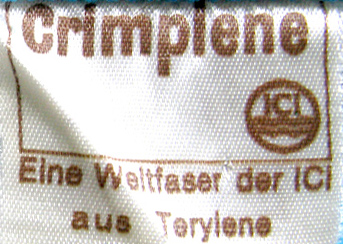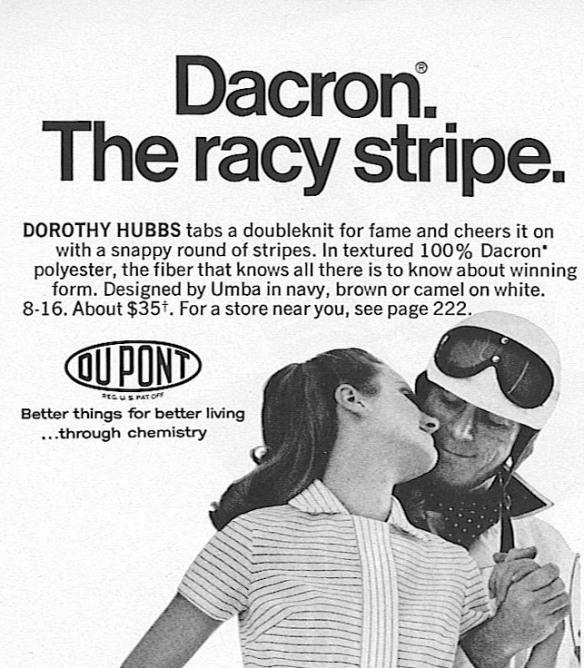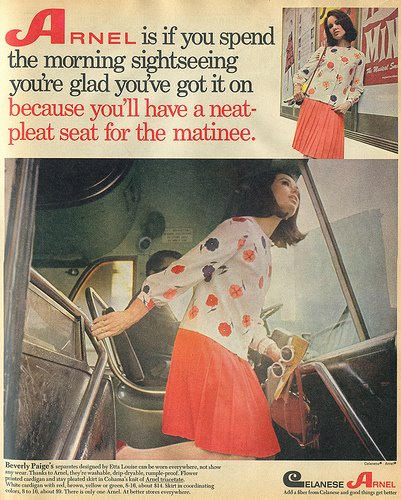The Vintage Fashion Guild recently released a comprehensive guide to fabrics, which includes textures, types of printed patterns, weave, and material. As I was perusing the different fabrics listed there were a few items I think needed to be mentioned to aid in dating vintage clothing as well. Some of these do fall under the category of Polyester and have Trademark names, because the fibres were produced/created by different companies. Companies like ENKA, Imperial Chemical Industries and Dupont. Polyesters are made from chemical substances found mainly in petroleum and are manufactured in fibers. I have included the link to this site:
http://vintagefashionguild.org/fabric-resource-a-z
Crimplene: (polyester) is a thick yarn used to make a fabric of the same name. The resulting cloth is heavy, wrinkle-resistant and retains its shape well. Britain’s defunct ICI Fibres Laboratory developed the fibre in the early 1950s and named it after the Crimple Valley in the UK in which the company was situated. Crimplene was used in garments that required a permanently pressed look, such as skirts and trousers. The fabric enjoyed popularity upon introduction in the 1950s in response to its convenient ‘wash-and-wear’ properties. Crimplene was often used to make the typical A-line dress and 1960s fashion. Likewise, it was popular amongst men in British MOD culture for use in garish button down shirts. In the early 1970s, Crimplene began to fall out of fashion. Other, lighter-weight polyester fabrics like Trevira replaced Crimplene for their ease of movement and ventilation.
Trevira: is a thermoplastic polymer resin of the polyester family and is used in synthetic fibers. Polyester is naturally resilient, meaning it doesn’t wrinkle easily and wrinkles tend to fall out overnight. There were a selection of Vintage Advertisements for this fabric in the 1970s in Vogue magazine.
Dacron: 1960/70s trademark for a polyester fiber. Dacron is a condensation polymer obtained from ethylene glycol and terephthalic acid. Its properties include high tensile strength, high resistance to stretching, both wet and dry, and good resistance to degradation by chemical bleaches and to abrasion. The continuous filament yarn is used in curtains, dress fabrics, high-pressure fire hoses, men’s shirts, and thread. The staple fiber is ideal for mixing with wool in men’s and women’s suits, as well as in dress fabrics, knitted wear, and washable woven sportswear.
Celanese Arnel: 1940/50s. AAn Acetate fiber. Just defined as ”synthetic fabric”. Later, you may get your knuckles rapped by the Celanese Corporation, which happens to make Arnel with a capital ”A” and points out that it is a triacetate fiber and not a fabric.
Orlon: Acrylic. The Dupont Corporation created the first acrylic fibers in 1941 and trademarked them under the name Orlon.
Bianchini Silk: Vintage fabric of silk made by reknowned manufacturer Bianchini- Ferier. Bianchini Férier (originally Atuyer Bianchini Férier) was created in 1888 by three former employees of one of the city’s renowned manufacturers of high fashion silks. They embarked on the manufacture and sale of the highest quality silk fabrics, the haute nouveauté. This was the sector of fabric manufacture most closely linked to Parisian high fashion dress design
Tricopaque: A blend of fibers, including Nylon. I have seen lounge wear in this fabric, most notably from Vanity Fair.
Some of the fabrics or fiber names you may come across in vintage clothing are trademarks and may be mentioned on the labels. These include Vycron, Encron, Corfam, Qiana, Avril, Antron III Nylon and Mylar.
For more information there is a comprehensive handy guide here:
http://reviews.ebay.com/Identifying-Fabrics-amp-Fibers-Details-amp-Burn-Tests?ugid=10000000000951489





